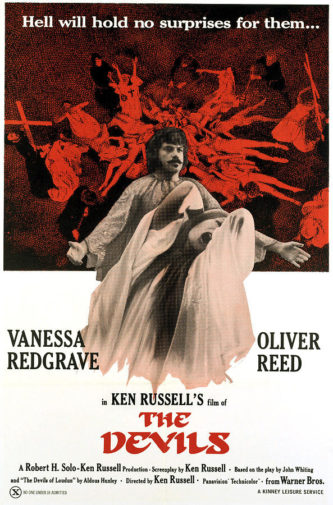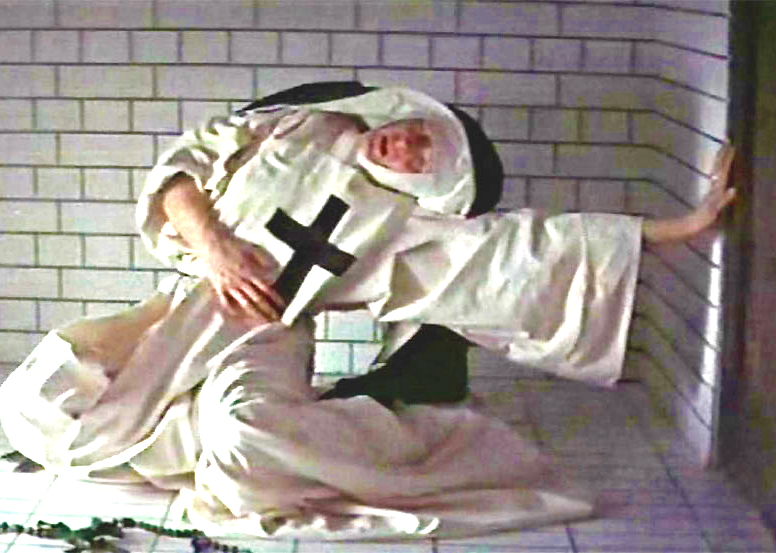 Almost certainly director Ken Russell’s finest achievement, and definitely one of the most significant British productions of the seventies (if not ever), THE DEVILS remains a transgressive masterpiece. It is also one of the most heavily censored films of all time; there exist at least five different versions, of which I’d recommend the most recent one that restores two pivotal sequences, although THE DEVILS is required viewing in any form.
Almost certainly director Ken Russell’s finest achievement, and definitely one of the most significant British productions of the seventies (if not ever), THE DEVILS remains a transgressive masterpiece. It is also one of the most heavily censored films of all time; there exist at least five different versions, of which I’d recommend the most recent one that restores two pivotal sequences, although THE DEVILS is required viewing in any form.
…director Ken Russell’s finest achievement, and definitely one of the most significant British productions of the seventies (if not ever)…
Quite possibly the ultimate “nunsploitation” movie, 1971’s THE DEVILS was adapted by the great Ken Russell (director of THE MUSIC LOVERS, TOMMY, THE LAIR OF THE WHITE WORM and many other unforgettable films) from Aldous Huxley’s THE DEVILS OF LOUDON, about a real incident that occurred in 17th Century France, and John Whiting’s play THE DEVILS, which was itself based on the Huxley book. The filming was reportedly as wild and unfettered as the film itself, with extras whose lascivious on-set behavior made headlines. The finished product deeply scandalized British and American censors, resulting in such an unholy frenzy of cutting that only in the past couple years has the film finally been restored to its original form.
…the ultimate “nunsploitation” movie, 1971’s THE DEVILS was adapted by the great Ken Russell…
Of the five cuts of THE DEVILS mentioned above, the most prominent is, unfortunately, the U.S. version prepared by Warner Bros., who saw fit to excise 4 minutes even though British censors had already made substantial cuts (Warner’s rationale, according to Russell, was “an apparent fear of pubic hair”). For years this was the only available version, at least until a slightly longer cut was made available via Asian laser disc in the early nineties, followed by a 1997 British VHS release that was even longer.
…U.S. version prepared by Warner Bros., who saw fit to excise 4 minutes even though British censors had already made substantial cuts…
Neither of those cuts of the film, however, contained the film’s most outrageous scene, the legendary “Rape of Christ” sequence that was long believed to be lost. But in 2002 a film can containing the sequence in question, along with other never-before-seen censored footage, was unearthed by the British film critic Mark Kermode and a newly restored version was released on DVD by the independent outfit Angel Digital. Puzzlingly, that version was still missing several censored bits shown in Kermode’s documentary HELL ON EARTH, most notably one where a pivotal character masturbates with a charred bone. That scene, together with the Rape of Christ sequence, did at last make it into a new, and presumably definitive, cut of THE DEVILS screened in London in late 2004.
That scene, together with the Rape of Christ sequence, did at last make it into a new, and presumably definitive, cut of THE DEVILS screened in London in late 2004.

Father Grandier is a kindly but lascivious priest who runs the fortified city of Loudon. The power mad Cardinal Richelieu seeks to solidify control over France by tearing down Loudon’s walls and claiming the property as his own, but a long-standing agreement between the King of France and Loudon’s former ruler prevents him from doing so. Yet when Grandier is accused of seducing a nun through witchcraft, Richelieu sees his chance at finally destroying Loudon.
The accuser is Sister Jeanne, a confused woman suffering from a rather severe case of old fashioned lust for Father Grandier. Naturally she believes he’s put a curse on her, a delusion all-too eagerly fostered by Richelieu, who calls in the loony Father Barre, an exorcist whose integrity is questionable, to say the least. Barre’s administrations succeed in driving Jeanne and her fellow nuns into a sexual frenzy, culminating in a vast orgy inside a church where a statue of Christ is ripped from a wall and graphically defiled.
 Grandier is hauled before a kangaroo court who accuse him of consorting with the Devil. From there he’s tortured in various hideous ways but refuses to confess. He’s burned at the stake in the town square, after which the walls of Loudon are summarily torn down and France assumes control over the property.
Grandier is hauled before a kangaroo court who accuse him of consorting with the Devil. From there he’s tortured in various hideous ways but refuses to confess. He’s burned at the stake in the town square, after which the walls of Loudon are summarily torn down and France assumes control over the property.
Those looking for elegance and restraint won’t find them here, as this is a bold and confrontational work unafraid of breaking taboos and giving offense (which is all the better if you ask me!). Neither is Ken Russell a great respecter of historical accuracy; together with production designer (and future director) Derek Jarman, avant-garde composer Peter Maxwell Davies and cinematographer David Watkin, he’s fashioned an expressionistic fantasy that seems designed to evoke the time the film was made (the early nineteen seventies) as much as it does the year 1634. Cardinal Richelieu’s place of residence, for instance, is explicitly patterned after a late 20th Century Prison complete with guards stationed at the front gate to let visitors in and out; likewise, the interior of Sister Jeanne’s abode, where she’s given an enema before a jeering crowd, is made to look like a public restroom with its white tiles and sink-like outcropping where the horrific event takes place (which Huxley’s text compares to a rape in a public lavatory). And note the pointed white hoods Grandier’s accusers wear, which look an awful lot like Ku Klux Klan garb.
Those looking for elegance and restraint won’t find them here, as this is a bold and confrontational work unafraid of breaking taboos and giving offense…
All the performers, from seasoned vets like Vanessa Redgrave (as the seemingly lobotomized Sister Jeanne) and Oliver Reed (as Father Grandier) to lesser known talents like Michael Gothard (also seen in SCREAM AND SCREAM AGAIN, who here plays Father Barre) and Georgina Hale (unforgettable as a white faced nun) seem to have understood and absorbed Russell’s intent, delivering performances that are wildly uninhibited, crazed and outlandish—much like the film itself.
Regarding the long excised “Rape of Christ” sequence (see above), I believe it’s an important part of the film. A mind blowing two minute mélange of screaming, nudity, masturbation and crazed, unfettered camerawork perversely intercut with Grandier praying to God in a serene countryside, it provides the insane behavior of the film’s nuns with an unforgettable apotheosis, and allows Russell’s frenzied moviemaking to reach a peak of mind blowing insanity of which previous versions of THE DEVILS only scratched the surface.
Vital Statistics
THE DEVILS
Warner Bros.
Director: Ken Russell
Producers: Robert H. Solo, Ken Russell
Screenplay: Ken Russell
(Based on the book THE DEVILS OF LOUDON by Aldous Huxley and the play THE DEVILS by John Whiting)
Cinematography: David Watkin
Editing: Michael Bradsell
Cast: Vanessa Redgrave, Oliver Reed, Dudley Sutton, Max Adrian, Murray Melvin, Gemma Jones, Georgina Hale, Michael Gothard, Brian Murphy, Christopher Logue, Andrew Faulds, Iza Teller, Judith Paris, John Woodvine, Catherine Willmer
